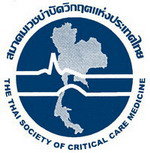Critical Care of Patients with Cancer (ตอนที่ 1)
Abstract
โรคมะเร็งยังเป็นปัญหาของระบบสาธารณสุขทั่วโลก ในประเทศที่พัฒนาแล้ว โรคมะเร็งเป็นสาเหตุ การเสียชีวิตที่สำคัญ ประเทศไทยก็เช่นเดียวกัน ปัจจุบันอุบัติการณ์ของผู้ป่วยที่รอดชีวิตจากมะเร็งมีมากขึ้นเนื่องจากการรักษามะเร็งก้าวหน้าไปอย่างรวดเร็ว นำไปสู่จำนวนผู้ป่วยที่ต้องรักษาแบบเข้มข้น (intensive care) โชคดีที่การพัฒนาการรักษามะเร็งมีประสิทธิภาพมากขึ้นความรู้ด้านเวชบำบัดวิกฤตก้าวหน้ามากขึ้นชัดเจน นำไปสู่การรอดชีวิตของผู้ป่วยมะเร็งที่มีภาวะ (อาการ) วิกฤตดีขึ้น ทำให้การแพทย์ในยุคนี้ “การดูแลรักษาภาวะวิกฤตจึงเป็นสิ่งสำคัญ” ในระบบการดูแลต่อเนื่องของผู้ป่วยมะเร็งที่มีภาวะวิกฤต ถึงแม้ว่าผู้ป่วยมะเร็งที่อยู่ในภาวะวิกฤตในการดูแล จึงไม่ได้แตกต่างจากผู้ป่วยวิกฤตอื่น ๆ แต่ก็มีหลายประเด็นที่เป็นความท้าทายและเฉพาะเจาะจงสำหรับผู้ป่วยมะเร็งที่อยู่ในภาวะวิกฤตนั้น ๆ ที่ต้องนำความรู้ในศาสตร์ และความชำนาญทักษะที่เฉพาะเจาะจง การบริหารจัดการ การดูแลผู้ป่วยมะเร็งที่อยู่ในภาวะวิกฤต และจำเป็นต้องเป็นสหสาขาวิชาชีพในสาขามะเร็งวิทยา เวชบำบัดวิกฤต และการดูแลแบบประคับประคอง ฉะนั้น การดูแลผู้ป่วยกลุ่มนี้ยังคงต้องยึดหลักการของการดูแลผู้ป่วยมะเร็ง ซึ่งเป็น “ the stateof-the-art” ในการดูแลผู้ป่วยมะเร็งที่อยู่ในภาวะวิกฤตที่ต้องคำนึงถึงปัจจัยเหล่านี้
- การพยากรณ์โรคในผู้ป่วยมะเร็งที่อยู่ในภาวะวิกฤตมีการพัฒนาอย่างมากในช่วง 10 ปีที่ผ่านมา
- การดูแลที่ดีที่สุด คือ การดูแลผู้ป่วยที่ต้องการผู้ที่มีความรู้ความเชี่ยวชาญเฉพาะทาง และเป็นสหสาขาวิชาชีพ
- โรคประจำตัว หรือลักษณะของผู้ป่วยที่มีมะเร็งเป็นโรคประจำตัวนั้น เช่น ชนิดของโรคมะเร็ง ระยะของ โรค หรือการกลับมาของโรคมะเร็ง ซึ่งมีผลกระทบต่อการรอดชีวิตของผู้ป่วยมะเร็งที่อยู่ในภาวะวิกฤตนั้นด้วย
มีการศึกษาที่แสดงให้เห็นว่า แนวโน้มของผลลัพธ์ในการดูแลผู้ป่วยมะเร็งที่อยู่ในภาวะวิกฤต ในผู้ป่วยที่มี hematologic หรือ solid tumor นั้นมีผลลัพธ์ที่ดีขึ้น อัตราการรอดชีวิตของผู้ป่วยกลุ่มนี้จากเดิมมีเพียงร้อยละ 20 - 30 เพิ่มขึ้นเป็นร้อยละ 50 - 60 และบางการศึกษาพบว่า อัตราการเสียชีวิตลดลงจากร้อยละ 70.4 เป็นร้อยละ 52 ถึงแม้ผู้ป่วยมะเร็งที่มีภาวะวิกฤตยังคงมีอัตราการเสียชีวิตที่สูงกว่าผู้ป่วยที่ไม่เป็นมะเร็งในภาวะวิกฤตก็ตาม แต่ก็ควรมีความยุติธรรม และจริยธรรมที่จะไม่ปฏิเสธผู้ป่วยมะเร็งที่จะต้องเข้ามาดูแลรักษาใน intensive care unit เช่นกัน
Downloads
References
Alexander S., Boris B., Matthias K., et al. Critical Care of Patients With Cancer. CA CANCER j CLIN. 2016; 66: 496-517.
Torre LA, Bray F, Siegel RL, Ferlay J, Lortet-Tieulent J, Jemal A. Global cancer statistics, 2012. CA Cancer J Clin. 2015;65: 87-108.
Siegel RL, Miller KD, Jemal A. Cancer statistics, 2016. CA Cancer J Clin. 2016;66:7-30.
Trinkaus MA, Lapinsky SE, Crump M, et al. Predictors of mortality in patients undergoing autologous hematopoietic cell transplantation admitted to the intensive care unit. Bone Marrow Transplant. 2009; 43: 411-415.
Huynh TN, Weigt SS, Belperio JA, Territo M, Keane MP. Outcome and prognostic indicators of atients with hematopoietic stem cell transplants admitted to the intensive care unit. J Transplant 009: 917294, 2009.
Kerhuel L, Amorim S, Azoulay E, Thieblemont C, Canet E. Clinical features of life-threatening complications following autologous stem cell transplantation in patients with lymphoma. Leuk Lymphoma. 2015;56:3090-3095.
Bernal T, Pardavila EV, Bonastre J, et al. Survival of hematological patients after discharge from the intensive care unit: a prospective observational study [serial online]. Crit Care. 2013;17:R302.
Benoit DD, Depuydt PO, Vandewoude KH, et al. Outcome in severely ill patients with hematological malignancies who received intravenous chemotherapy in the intensive care unit. Intensive Care Med. 2006; 32:93-99.
Wohlfarth P, Staudinger T, Sperr WR, et al. Prognostic factors, longterm survival, and outcome of cancer patients receiving chemotherapy in the intensive care unit. Ann Hematol. 2014;93:1629-1636.
Pitello N, Treon M, Jones KL, Kiel PJ. Approaches for administering chemotherapy in the intensive care unit. Curr Drug Saf. 2010;5:22- 32.
Song JU, Suh GY, Chung MP, et al. Risk factors to predict outcome in critically ill cancer patients receiving chemotherapy in the intensive care unit. Support Care Cancer. 2011;19:491-495.
Schnell D, Besset S, Lengline E, et al. Impact of a recent chemotherapy on the duration and intensity of the norepinephrine support during septic shock. Shock. 2013;39:138-143.
Darmon M, Thiery G, Ciroldi M, et al. Intensive care in patients with newly diagnosed malignancies and a need for cancer chemotherapy. Crit Care Med. 2005;33: 2488-2493.
Reisfield GM, Wallace SK, Munsell MF, Webb FJ, Alvarez ER, Wilson GR. Survival in cancer patients undergoing in-hospital cardiopulmonary resuscitation: a metaanalysis. Resuscitation. 2006;71:152- 160.
Tian J, Kaufman DA, Zarich S, et al. Outcomes of critically ill patients who received cardiopulmonary resuscitation. Am J Respir Crit Care Med. 2010;182: 501-506.
Champigneulle B, Merceron S, Lemiale V, et al. What is the outcome of cancer patients admitted to the ICU after cardiac arrest? Results from a multicenter study. Resuscitation. 2015;92:38-44.
Zhang B, Nilsson ME, Prigerson HG. Factors important to patients’ quality of life at the end of life. Arch Intern Med. 2012;172: 1133- 1142.
Voigt LP, Rajendram P, Shuman AG, et al. Characteristics and outcomes of ethics consultations in an oncologic intensive care unit. J Intensive Care Med. 2015;30: 436-442.





